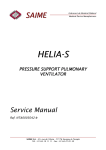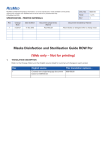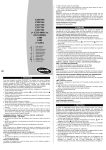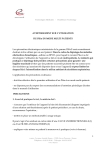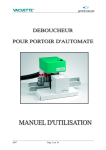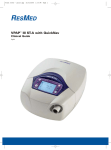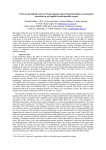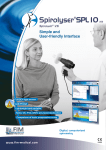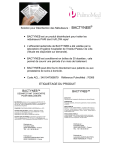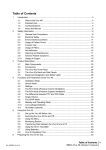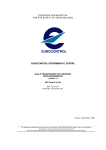Download VS Serena
Transcript
User's Manual VS Serena Réf. NEAT0202079-K from version 2.04 Z.I – 25, rue de l'Etain – 77176 SAVIGNY LE TEMPLE – FRANCE Tél. +33 (0)1 64 19 11 11 – Fax +33 (0)1 64 41 81 30 / +33 (0)1 64 41 80 31 User's Manual NEAT0202079-K VS Serena 2/31 User's Manual VS Serena User’s manual VS Serena Reference : NEAT0202079-K From version 2.04 0197 Manufacturer : SAIME Z.I – 25, rue de l'Etain – 77176 SAVIGNY LE TEMPLE – FRANCE Tél. +33 (0)1 64 19 11 11 – Fax +33 (0)1 64 41 81 30 / +33 (0)1 64 41 80 31 NEAT0202079-K 3/31 User's Manual NEAT0202079-K VS Serena 4/31 User's Manual VS Serena WARNINGS ) This manual should be read and understood before using this device on a patient. ) This User’s Manual goes with a Service Manual NTA0208095 which should be read and understood by the technical staff in charge of the overhaul. ) Professionally trained and competent personnel working under the doctor's responsibility may carry out the settings. ) A medical doctor should decide the ventilation settings. ) This device has been classified as fit for adult and paediatric ventilation. ) This device must not be used for life support. ) This device has been approved for a continuous service. ) The device should not be restarted immediately if conditions of storage and/or transport are different than the recommended operating conditions. ) The device should not be used onto the mains without being removed from its transport bag. ) SAIME is willing to provide further information on the steps taken to guarantee the cleanliness of the respirator elements during the production and delivery phases. ) The device should be used only in its normal operating position, placed firmly on its feet. ) Use the unit's carry handle for the transport and handling. Do not use the device carry handle if a patient is being ventilated on the machine. ) Do not block up the ventilator's inlets. ) The device must not be covered or placed in such a way as to adversely affect ventilation. ) The complete patient circuit should be thoroughly checked for leaks or defects before connecting the patient. ) The pressure in the ventilator is greater than the atmospheric pressure at all times during the exhale cycle. ) The device and the turbine conception have been designed in such a way as to limit the output pressure to a maximum of 39 hPa. ) The alarms should be checked regularly, especially before the ventilator is used on the patient and when used for on-going home ventilation. ) This device should not be used with inflammable anaesthetic agents. ) The ventilator may dysfunction if used in the presence of devices that generate short wavelengths or high frequencies (defibrillators, diathermia devices, electro surgical devices, X-ray devices, cellular phones, etc…). NEAT0202079-K 5/31 User's Manual VS Serena ) Electromagnetic fields exceeding 10 V/m may adversely affect the ventilator. ) This device should not be used with patient circuits made with current conducting material. ) No device sterile, under non-watertight film wrapping. ) Do not expose the ventilator to direct sunlight. ) This device is fragile. Do not handle it roughly. ) AC mains supply must be in conformity with local regulation. ) The ventilator should be run from its external DC supply, in case of serious mains supply disturbances. ) In case of a prolonged storage without being connected onto the mains, the back-up battery naturally runs down. When starting the device, if the back-up battery alarm releases, connect the device onto the mains for several hours. ) Make sure that the total resistance of the patient circuit and ventilation accessories does not exceed 6 hPa at 60 litres/minute for adults and 6 hPa at 30 litres/minute for children. ) All faulty fuses on the supply board should be replaced with identical fuses respecting identical standards. The primary fuse on the mains socket protects the transformer from overload. ) Before every use on a new patient and when using the device for the first time, the ventilator must be cleaned and disinfected according to the procedure (see chapter “Maintenance and Disinfection”). ) The ventilator should be disinfected and decontaminated as per the manufacturer's indications and the procedure(s) set down by the hospital or the home ventilation care organisation. ) Power supply 230/100 VAC 50-60 Hz 52 VA and/or external supply 26 VDC, 3A maxi (medical CE EN 606011). ) The specific cable delivered with the device should supply the appliance current, using another model could be dangerous for the patient. ) The device and its user's manual have obtained the CE-marking (TÜV Rheinland). Every used accessory should be CE too. ) The re-inhalation of the carbon dioxide is limited by the leaks at the mask and the cleaning of the circuit by the constant flow circulation. ) The serial number of the device gives the product code, the manufacturing year and month, the number of the device in the month. )In case of a technical alarm, switch off the device plug it from the mains and from O2 supply. NEAT0202079-K 6/31 User's Manual VS Serena ) This device should be disposed of separately, not as unsorted waste To dispose of your device, you should use appropriate collection, reuse and recycling systems available in your region. The use of these collection, reuse and recycling systems is designed to reduce pressure on natural resources and prevent hazardous substances from damaging the environment This directive applies to all devices manufactured after august 2005 and with serial numbers bigger than VS0508001; Example : year NEAT0202079-K number in the month VS 02 07 003 month 7/31 User's Manual VS Serena Packing list DESIGNATION Kit Accessories (KIT012892) Mains cord (COR011870) Certificate of conformity User’s manual Recommendation concerning safe battery Tubes 180 cm (TUY010993) Filter Mains cord connection and claw Fuse Tube 1,80 m Vs Saime Bag NEAT0202079-K 8/31 User's Manual VS Serena Recommendations The Vs bi-level has been made to work in an optimum way with different types of leaks masks present on the market. The characteristics of those masks have been taken into account in the algorithms of calculations. However, the use of a facial mask can slightly modify the sensibility of the triggering. In this configuration, it is recommended to use the ST mode and the AUTO Start function disactivated (NO). With software version 2.04, we recommend the following RESMED1 masks when using an open circuit ventilation (i.e. leakage): 16518 16519 16545 16546 16578 60003 60004 60103 60104 60105 60011 632003 632004 60610 60611 60612 60613 60614 60615 KIT MASQUE MIRAGE STANDARD for PPC KIT MASQUE MIRAGE LARGE for PPC KIT MASQUE ULTRA MIRAGE PPC STANDARD KIT MASQUE ULTRA MIRAGE PPC LARGE ULTRA MIRAGE MASK SHALLOW –WIDE CE ENSEMBLE MASQUE MIRAGE VISTA STANDARD ENSEMBLE MASQUE MIRAGE VISTA PROFOND MASQUE MIRAGE ACTIVA STANDARD MASQUE MIRAGE ACTIVA LARGE MASQUE MIRAGE ACTIVA SHALLOW MASQUE MIRAGE KIDSTA SML KIT COMPLET MASK PAPILLON TAILLE 1 KIT COMPLET MASK PAPILLON TAILLE 2 LARGE MASQUE FACIAL ULTRA MIRAGE PETIT STD MASQUE FACIAL ULTRA MIRAGE PETIT SHALLOW MASQUE FACIAL ULTRA MIRAGE MEDIUM STD MASQUE FACIAL ULTRA MIRAGE MEDIUM SHALLOW MASQUE FACIAL ULTRA MIRAGE LARGE STD MASQUE FACIAL ULTRA MIRAGE LARGE SHALLOW CAUTION KIT MASQUE MIRAGE SWIFT TAILLES S/M/L (RESMED, reference 60506) must not be used with version 2.04. 1 or equivalent. NEAT0202079-K 9/31 User's Manual VS Serena With software version 2.03 and former versions, we recommend the following RESMED2 masks when using an open circuit ventilation (i.e. leakage): 16518 16519 16545 16546 16578 60003 60004 60103 60104 60105 60011 632003 632004 KIT MASQUE MIRAGE STANDARD for PPC KIT MASQUE MIRAGE LARGE for PPC KIT MASQUE ULTRA MIRAGE PPC STANDARD KIT MASQUE ULTRA MIRAGE PPC LARGE ULTRA MIRAGE MASK SHALLOW –WIDE CE ENSEMBLE MASQUE MIRAGE VISTA STANDARD ENSEMBLE MASQUE MIRAGE VISTA PROFOND MASQUE MIRAGE ACTIVA STANDARD MASQUE MIRAGE ACTIVA LARGE MASQUE MIRAGE ACTIVA SHALLOW MASQUE MIRAGE KIDSTA SML KIT COMPLET MASK PAPILLON TAILLE 1 KIT COMPLET MASK PAPILLON TAILLE 2 LARGE CAUTION The following masks must not be used with version 2.03 and former versions: 60610 60611 60612 60613 60614 60615 60506 2 MASQUE FACIAL ULTRA MIRAGE PETIT STD MASQUE FACIAL ULTRA MIRAGE PETIT SHALLOW MASQUE FACIAL ULTRA MIRAGE MEDIUM STD MASQUE FACIAL ULTRA MIRAGE MEDIUM SHALLOW MASQUE FACIAL ULTRA MIRAGE LARGE STD MASQUE FACIAL ULTRA MIRAGE LARGE SHALLOW KIT MASQUE MIRAGE SWIFT TAILLES S/M/L or equivalent. NEAT0202079-K 10/31 User's Manual VS Serena The VS bi-level can also be connected with a humidifier as : Fisher & Paykel type "HC150", or equivalent. NEAT0202079-K 11/31 User's Manual VS Serena Contents 1. Description and Assembling................................................................................................ 14 1.1 1.2 1.3 1.4 Definition and field of application ....................................................................................................... 14 Screen / Buttons.................................................................................................................................. 14 Patient circuit Connection.................................................................................................................... 14 Rear lay-out .......................................................................................................................................... 15 2. Start / Stop............................................................................................................................ 16 2.1 2.2 2.3 Start ...................................................................................................................................................... 16 Control of the functioning and conditioning for a new patient ............................................................ 16 Stop ....................................................................................................................................................... 17 3. Supplies ................................................................................................................................ 18 3.1 3.2 Types..................................................................................................................................................... 18 Priority ................................................................................................................................................. 18 4. Access without unlocking .................................................................................................... 19 4.1 4.2 The measures ........................................................................................................................................ 19 The slope............................................................................................................................................... 19 5. Setting access ....................................................................................................................... 20 5.1 5.2 5.3 Unlocking ............................................................................................................................................. 20 Selecting ............................................................................................................................................. 20 Adjusting............................................................................................................................................... 20 6. Ventilation Modes ................................................................................................................ 21 6.1 6.2 6.3 The S mode : spontaneous mode (f min = NO) .................................................................................... 21 The ST mode : spontaneous mode with minimum frequency (f min ≥ 5 c/min).................................... 21 The T(s) mode : timed mode with frequency ........................................................................................ 21 7. The parameters .................................................................................................................... 22 7.1 7.2 7.3 Definition.............................................................................................................................................. 22 Parameters chart depending on the ventilation modes ........................................................................ 22 Units and accuracy............................................................................................................................... 23 8. The Alarms........................................................................................................................... 24 8.1 8.2 Definitions ............................................................................................................................................ 24 Alarms Priorities .................................................................................................................................. 24 9. Maintenance and disinfection............................................................................................. 25 9.1 9.2 9.3 9.4 Fuses replacement ................................................................................................................................ 25 Dust Filter replacement........................................................................................................................ 25 Replacement of the internal filter ......................................................................................................... 25 Check the calibration ........................................................................................................................... 25 NEAT0202079-K 12/31 User's Manual 9.5 VS Serena Cleaning / Sterilising............................................................................................................................ 25 10. Technical Characteristics.................................................................................................... 27 10.1 10.2 10.3 10.4 10.5 10.6 10.7 Synoptic ................................................................................................................................................ 27 Functioning .......................................................................................................................................... 28 Power supply ........................................................................................................................................ 28 Specifications........................................................................................................................................ 28 Use, storage and transport conditions ................................................................................................. 29 Applied standards................................................................................................................................. 29 Accessories technical specifications..................................................................................................... 30 11. Symbols................................................................................................................................. 31 NEAT0202079-K 13/31 User's Manual VS Serena 1. Description and Assembling 1.1 Definition and field of application VSSerena is a device used for the two pressure levels non-invasive ventilation, for adult or paediatric patients, at hospital and / or at home if the patient has enough spontaneous ventilation. This device is not designed for neonatal use. The device should be used with a single-circuit system and a leaks mask. The device has four leakage modes : ¾ S : Spontaneous ¾ ST : Spontaneous with security frequency ¾ CPAP : Continuous Positive Airway Pressure (when EPAP = IPAP) ¾ T(s) : Timed mode with frequency 1.2 Screen / Buttons Opened padlock Type of used supply Adjustment buttons Menu Alarm Silence Bargraph Slope Alarm led On / Off 1.3 Patient circuit Connection Before starting the Bi-level, connect the patient circuit : Insufflation (towards patient) Note : Check the settings and alarms adjustment before connecting on the patient. The insufflation connector has a standard size (22 mm). NEAT0202079-K 14/31 User's Manual VS Serena 1.4 Rear lay-out Serial line External supply Mains Tension selector 100/230VAC Fuse drawer Note : the safety hook near the mains connection protects the device against the accidental disconnection of the mains. It should be put on the mains cord after the connection (see picture below). Gas inlet Gas inlet Caution: connectors of the rear panel are not protected against electrostatic discharges. Note: make sure that the ventilator’s inlets are not blocked up. Note: when the switch is commutated on 220, the device can function on 230 VAC. When the switch is in position 100, the device can function on 100V or 120V, according to the checked box. NEAT0202079-K 15/31 User's Manual VS Serena 2. Start / Stop 2.1 Start - Mains cord connection : the device is in stand by mode. The following screen appears with mains symbol, date, hour, version : - Date and hour settings : In stand by mode, press the Menu button until the date flashing. Adjust date and hour with + and - buttons, then confirm by pressing the Menu button until the date and hour stop flashing. - Starting : Press on the button, a buzzer rings out, the device starts on. Note : when the device is turned on, two counters of hours are displayed and also the country of use : y Patient : 00000 h y Device : 00000 h - To reset the patient counter : press simultaneously trends memory. and while it appears. Warning : this resets the While the above counters are displayed, press one second on the Menu button in order to display the Meca parameter (turbine overhaul) instead of the Device counter : y Meca : 00000 (refer to the Service Manual NTA0208095) - To set the device with the manufacturing parameters : while the Meca counter displays, after the device turns on, press simultaneously and . Warning : this resets the trends memory and the Patient counter. 2.2 Control of the functioning and conditioning for a new patient Before every use on a new patient and when using the device for the first time, the ventilator must be cleaned and disinfected according to the procedure (see chapter “Maintenance and Disinfection”). To check the functioning of the device : - Assembly the patient circuit with a balloon (a SIEMENS® for example) and then start the device Check the pressure on the bargraph, the measures and the alarms triggering (see “Procedure of alarms checking” chapter 8). Check also the similarity between the settings and the measures made by the device (see “Units and accuracy” chapter 7). Pressing one second on the button and check the display of the measured frequency and the delivered tidal volume. The screens disappear after 10 s. NEAT0202079-K 16/31 User's Manual VS Serena 2.3 Stop - Stop : press two seconds on the button, the ventilation stops and the device is in stand by mode. - Disconnection of the mains cord : a continuous buzzer rings out, to confirm press on the button. Note : the patient can automatically starts the device, when the function is activated (Yes). In the S and CPAP modes, the Bi-level is automatically in stand by mode if the patient stops ventilation himself (putting out the mask). To connect onto the mains does not inhibit the continuous alarm, you have to deactivate it by pressing the Silence Alarm button NEAT0202079-K 17/31 User's Manual VS Serena 3. Supplies 3.1 Types "" symbol displays behind the used supply : AC Mains External supply Note : only the connected supplies are shown at the top right of the screen. CAUTION This device includes a safe battery. We strongly recommend before any use to connect the device to the mains power for 24h in order to ensure the optimum charge of the batteries. In a general way, for an optimum use, a minimum time of charge of 24h is necessary after storage for more than 4 weeks 3.2 Priority The mains has always priority over the other supplies. NEAT0202079-K 18/31 User's Manual VS Serena 4. Access without unlocking 4.1 The measures - The pressure is indicated on the bargraph (1 block = 1 hPa) - Two measures display on the screen by pressing on the During this display, press on the and button, they disappear after 10s. buttons to accede to the IPAP, EPAP and f min parameters. The measures are : - Tv = estimated patient tidal volume - f = patient frequency Note : The measures are also accessible when the device is unlocked. 4.2 The slope It is the rising time between the expiratory and inspiratory pressure. To select this parameter, press on the Adjust with the and button until the slope symbol appears. buttons. The adjustment values are: NEAT0202079-K 0 minimal 1 400 ms 2 600 ms 3 800 ms 19/31 User's Manual VS Serena 5. Setting access 5.1 Unlocking It allows to accede to the following parameters : - The ventilation mode (if f min ≥5 c/min, the ST mode is activated, if f min < 5 c/min the S mode is activated) - The inspiratory and expiratory pressure (IPAP / EPAP) - The inspiratory time Ti min / Ti max (not in CPAP mode) - The minimum frequency (f min) - The trigger (Trig.) - Automatic starting - The measures - The slope - The ramp (only in CPAP mode) To accede to this menu, press on the The device is unlocked. button until the audible bip. The Note : to lock the device, press again on the for two minutes, the device is automatically locked. symbol appears on the screen. button until the padlock disappears. If no button is activated 5.2 Selecting To select a parameter, scroll with the If you press the button until the requested parameter appears. button while you maintain pressed the button, you could go back in the Menu. 5.3 Adjusting Once the selected parameter, adjust the value with the NEAT0202079-K button to increase, the button to decrease. 20/31 User's Manual VS Serena 6. Ventilation Modes 6.1 The S mode : spontaneous mode (f min = NO) This mode is a two pressure levels ventilation. The frequency and the inspiratory time are entirely patient triggered. The adjustable parameters are : - The inspiratory pressure (IPAP) - The expiratory pressure (EPAP) - The minimum frequency (f min No) - The minimum inspiratory time (Ti min) - The maximum inspiratory time (Ti max) - Automatic starting - The slope Note : in the case IPAP=EPAP, the CPAP mode appears, the "slope" symbol and "f min" disappear. Then you can adjust the ramp. 6.2 The ST mode : spontaneous mode with minimum frequency (f min ≥ 5 c/min) In addition to the S mode characteristics, this mode allows to adjust a security frequency (f min). The adjustable parameters are : - The inspiratory pressure (IPAP) - The expiratory pressure (EPAP) - The minimum frequency (f min) - The minimum inspiratory time (Ti min) - The maximum inspiratory time (Ti max) - The trigger (Trig. Yes) - Automatic starting - The slope 6.3 The T(s) mode : timed mode with frequency The adjustable parameters are : NEAT0202079-K - The inspiratory pressure (IPAP) - The expiratory pressure (EPAP) - The frequency (f) - The minimum inspiratory time (Ti min) - The maximum inspiratory time (Ti max) - The trigger (Trig. No) - Automatic starting - The slope 21/31 User's Manual VS Serena 7. The parameters 7.1 Definition IPAP (Inspiratory Positive Airway Pressure) : inspiratory pressure delivered by the device. It cannot be less than the expiratory pressure + 2 hPa (except in CPAP and S modes). EPAP (Expiratory Positive Airway Pressure) : expiratory pressure delivered by the device. The frequency (f) : minimal number of cycles per minute delivered by the device to the patient in ST mode. - If f min < 5 c/min , f min = No Æ S mode - In T(s) mode, f min is replaced by f. The inspiratory time (Ti) : inspiratory phase of each cycle. It can be adjusted as : - a minimum : Ti min (this parameter has always priority over Ti max) - a maximum : Ti max Note : Ti max ≥ Ti min + 0,3 s The trigger : allows the patient to release himself inspiration cycles. This function is adjusted : from the ST mode (Trig. Yes) to the T(s) mode (Trig. No). The automatic starting : This function can be activated or not (Yes/No). It allows the patient to be able to start the device when he wants by breathing through the mask. Note : moreover it allows the device to be automatically in stand by mode after 30 s if the patient put out his mask (only in S and CPAP modes and when the device is locked). 7.2 Parameters chart depending on the ventilation modes Ventilation Modes S Parameters 5Æ30 IPAP (hPa) 4Æ20 EPAP (hPa) No f min (cycles/min) 2 0,3Æ2,5 Ti min (seconds) 2 1Æ3 Ti max (seconds) AUTO1 Trigger (Trig.) 0/1/2/3 Slope -Ramp (min) Yes/No Automatic starting 1 2 CPAP ST T(s) 4Æ20 4Æ20 No --AUTO1 -No / 5-45 Yes/No 6Æ30 4Æ20 5Æ50 0,3Æ2,5 1Æ3 Yes 0/1/2/3 -Yes/No 6Æ30 4Æ20 (f) 5Æ50 0,3Æ2,5 1Æ3 No 0/1/2/3 Padlock Yes/No : in CPAP and S mode, the "Trig." parameter does not appear, the trigger is automatic. : Ti min and Ti max depend on the frequency adjusted. Note : The IPAPmax pressure is limited to 30 hPa The IPAPmin is limited to : - in S mode Æ IPAP ≥ EPAP + 1 hPa - in ST mode Æ IPAP ≥ EPAP + 2hPa NEAT0202079-K 22/31 User's Manual VS Serena 7.3 Units and accuracy Adjustable Parameters Æ Inspiration (IPAP) Unit : hectopascal (hPa) Readings accuracy : +/- 1 hPa Setting accuracy : +/- 2 hPa** Æ Expiration (EPAP) Unit : hectopascal (hPa) Readings accuracy : +/- 1 hPa Setting accuracy : +/- 2 hPa** Æ Minimum Frequency (f min) Unit : cycles/minute (c/min) Readings accuracy : +/- 1 c/min Setting accuracy : period 10 ms Æ Minimum inspiratory time (Ti min) Unit : seconds (s) Readings accuracy : +/- 0,1 s Setting accuracy : +/- 10 ms Æ Maximum inspiratory time (Ti max) Unit : seconds (s) Readings accuracy : +/- 0,1 s Setting accuracy : +/- 10 ms Measures Æ Estimated Tidal Volume (Tv) Unit : litre (L) Readings accuracy : +/- 0,01 L Measure accuracy : estimation* Æ Frequency (f) Unit : cycles/minute (c/min) Readings accuracy : +/- 1 c/min Measure accuracy : +/- 1 c/min Æ Pressure Unit : hectopascal (hPa) Readings accuracy : 1 = 1 hPa Measure accuracy (bargraph) : +/- 2 hPa** * : The precision depends on the used mask. The tidal volume measures correspond to ATPD conditions (no humidity in the air). ** : Accuracy : +/- 2% of the full scale + 4% of the readings (EN 17510) NEAT0202079-K 23/31 User's Manual VS Serena 8. The Alarms 8.1 Definitions When an alarm is activated, a message flashes on the screen and a buzzer rings out. 8.1.1 The automatic alarms Continuous Buzzer Alarm : No supply connected. The device stops. Mains ! : No more mains supply with at least an other supply connected. Check the mains supply connection. Disconnection : High flow and pressure almost zero. Check the patient circuit. Note : In S mode, this alarm is inactive if the automatic starting is selected (Yes). 8.1.2 The technical alarms Global technical alarm Stopped turbine Low tension of the back-up battery. Connect onto the mains. Check date and hour. ¾ Procedure of alarms checking Mains ! : No more mains supply. Disconnect the mains cord with an other external alimentation connected Disconnection : disconnect the patient circuit. 8.2 Alarms Priorities The alarms priorities are represented by the flashing red led on the 8.2.1 High Priority This priority is represented by : 8.2.2 a quick flashing led and a buzzer ringing out every 8 seconds (yyy yy) or a continuous buzzer ringing out in case of defect stop of the device Medium Priority This priority is represented by : 8.2.3 button and by a buzzer. - a moderate flashing led - a buzzer ringing every 20 seconds (y y y) Low Priority This priority is represented by : - a continuous led - a discontinuous buzzer every 5 seconds (y y) For any further persistent alarm, or in case of any doubt, please contact your technician. NEAT0202079-K 24/31 User's Manual VS Serena 9. Maintenance and disinfection 9.1 Fuses replacement Time lagged fuse, cutting high power : - T 630mA H 250V for a use on to the 230 VAC mains - T 1.25A H 250V for a use on to the 100 VAC mains 9.2 Dust Filter replacement Before every use on a new patient, check the dust filter which is on the rear face. Note : we recommend to replace this filter for each use on a new patient. 9.3 Replacement of the internal filter The air filter placed into the turbine compartment has to be replaced by a qualified technician. Note : we recommend to replace the internal filter yearly. 9.4 Check the calibration Check the calibration of the pressure measurement between each patient or/and yearly (cf. the procedure in the service manual NTA0208095). 9.5 Cleaning / Sterilising 9.5.1 Frequency The disposable ventilator elements should be cleaned or replaced in accordance with either the manufacturer's instructions or the medical policy in operation on the place of use. For any new patient, the process is as indicated : Element Interval New patient Patient circuits Heating chamber Bacteria filter Yes Yes Yes 9.5.2 Frequency given by constructor Yes Yes Yes Frequency given by medical staff Yes Yes Yes Patient Circuit Reusable patient circuit elements should be disinfected and cleaned as per the manufacturer's recommendations. The reusable patient circuit should be regularly cleaned with soapy water, rinsed with clear water and dried before re-use. This basic maintenance procedure is recommended for home ventilation on one single patient. Cold disinfecting by immersion is also possible. Use the BACTINYL® 5M solution or equivalent. 9.5.3 Bacteria filter Bacteria filters situated in the inspiratory circuit and used for bacterial and viral filtering should be replaced in accordance with manufacturer's instructions and for each new patient. NEAT0202079-K 25/31 User's Manual 9.5.4 VS Serena External units parts The external parts of the ventilator can be cleaned with a dry cloth or, if necessary, a slightly wet sponge. Do not use abrasive powders, alcohol or solvents. 9.5.5 Heating chamber (humidifier) We recommend the use of disposable chambers. Disposable heating chambers should not be put into an autoclave. They should not be used with solutions containing phenol, ketene, formaldehyde, hypochloride, chlorinated hydrocarbons, aromatic hydrocarbons, and organic acids. For reusable chambers, cold decontamination by immersion is also possible. Use a 2% or 4% of BACTINYL® instrumentation liquid soap solution or equivalent. Should you wish to disinfect an element after decontamination, use a 2% BACTINYL® 5M solution. Follow the same procedure as for the BACTINYL® instrumentation liquid soap. 9.5.6 Technical properties of BACTYNIL® 5M BACTINYL®5M is a concentrated disinfectant : SPORICIDE, FUNGICIDE, BACTERICIDE & VIRUCIDE. BACTINYL®5M is used with clean materials, which has been decontaminated beforehand with soapy water. • Use 1. 2. 3. 4. 5. Prepare an immersion bath (at 2% for products not ready to be used) in cold or lukewarm water. Completely immerse the equipment to be disinfected (both the patient circuit and the removable parts). Leave it in the water for 15 minutes. Rinse with sterile water (or water with low bacteria count). Let dry • Caution Do not use with other products. Do not swallow. Rinse with clear water if the product is in contact with skin or eyes. • Information For surface disinfecting, SAIME recommends BACTINYL® (FUNGICIDE, BACTERICIDE, and VIRUCIDE). The F. GARCIN pharmaceutical laboratories manufacture BACTINYL® : 63000 CLERMONT-FERRAND, FRANCE. Any equivalent chemical can be used. WARNING : Maintenance centres may use other decontamination procedures. However, they must be approved and respect current rules and regulations. If other products are used, they must respect the conditions detailed in the French Pharmacopoeia. They must guarantee the absence of all residual products and they must not interfere with the ventilator's operation. Furthermore, they must not be in contradiction with the security measures recommended by SAIME. Note : due to the device conception, in leakage ventilation, the contamination by the expired gas of the patient is highly limited to the pneumatic circuit. Indeed at the time of the active expiration of the patient when the cycle begins, there is a column of clean air between the device and the patient (volume of the patient circuit).During the passive phase of the expiratory cycle, a constant flow allows the expired gas to be evacuated by the leaks of the mask (cleaning). Nevertheless, using a bateria filter is the only precaution which assures an optimal protection (particularly in hospital). So we recommend the change of the patient circuit for each new patient. The pneumatic elements and the internal foams are not submitted to the same conditions. NEAT0202079-K 26/31 User's Manual VS Serena 10. Technical Characteristics 10.1 Synoptic AC Mains AC connector Fuses Selector 100/230V External Supply inlet RS232 connector EMIFilter Transformer Display Keyboard CPU BOARD Power supply Voltage Selector RS 232 line Buzzer Distribution µP Rotative valve Saveguard Battery Watchdog Pressure sensor Memory Pressure sensor Rotative Valve motor Blower Speed Signal Blower Speed Driver Exhaust Rotative valve Blower Dust Filter Air inlet Legend : - Electric Line - Pneumatic Line NEAT0202079-K Insufflation port Electric line Pneumatic line 27/31 User's Manual VS Serena 10.2 Functioning The gas source is driven by an internal blower (the external air is inhaled through a dust filter). The positive inspiratory and expiratory pressures are driven at the settings with a pneumatic distributor. During the insufflation, a rotating valve drives the air of the blower towards the patient. At the expiration, it drives the expired gas through the exhalation outlet. Thus it reduces the concentration of re-inhaled CO2 during the next cycle. Inspiratory and Expiratory triggers are based on inspiratory Pressure signal analysis, pressure settings and closed loop blower signal. 10.3 Power supply Class II, type BF device Mains : 230/100 VAC 50-60 Hz 52 VA Imax = 630 mA External supply : 26 VDC +/- 10 % 3A maximum (CE medical EN60601-1) 10.4 Specifications Sound level : 29 dBA (measured under ISO3744 & EN17510 standard) Weight : 2,5 kg Dimensions : 135 mm x 285 mm x 204 mm Compliance : no measurable Maximum adjusted pressure : 30 hPa Maximum pressure in 1st fault condition : 39 hPa Flow at 10, 20, 30 hPa : 204 L/min, 180 L/min, 168 L/min Deliverable maximum minute volume : In the optimal adjustment conditions, IPAP=30, EPAP=4, various frequency, and for the following physiological characteristics : Rp = 20 C=0,05 V=20 L/min Rp = 5 C=0,05 V=35 L/min N N Inspiratory resistance : Flow = 60L/min R = 4,7 hPa (+ tube resistance) Expiratory resistance : Flow = 60L/min R = 4,3 hPa (+ tube resistance) Used materials in direct contact with patient gaz : ABS, Aluminium, Silicon, Stainless steel, Polyester, Brass, Chrome. NEAT0202079-K 28/31 User's Manual VS Serena 10.5 Use, storage and transport conditions Æ Current use Operating temperature from -5°C to +40°C Relative humidity from 30 % to 75 % Pressure from 700 to 1060 hPa Æ Storage Device with its accessories in original boxes : Storage temperature from -10°C to +50°C Relative humidity from 10% to 90% Do not store in humid conditions. The device is fragile, it should be stored as it is used. Device with its accessories not in original boxes : Storage temperature from -10°C +50°C Relative humidity from 10% to 90% Do not store in humid conditions. The device is fragile, it should be stored as it is used. Æ Transport Transport temperature from -10°C +50°C Relative humidity from 10% to 90% The ventilator and its accessories should be placed in their original SAIME packaging for transport. Warnings : - Fragile device, sensible to humidity, respect the transport position - Transport temperature : from -10°C to +60°C Note : in case of default of one of those following variations, the device works : - Temperature : from -5° to + 40°C - Relative humidity : from +10% to + 95% RH - Atmospheric pressure : from 700 mb to 1060 mb - Mains tension : from -15 % to +10% nominal. - External supply : from 26 V –15% to +25% 10.6 Applied standards The device meets with the following standards : • EN 60 601-1 For electromedical devices (safety rules). • IEC 601-1-4 For electromedical devices (programmable systems). • EN 60 601-1-2 : Compatibilité électromagnétique pour les appareils électromédicaux. − EN 55 011-classe B − EN 61 000-4-2 − EN 61 000-4-3 − EN 61 000-4-4 − EN 61 000-4-5 − EN 61 000-4-6 − EN 61 000-4-8 − EN 61 000-4-11 − CEI 801-3 − EN 61000-3-2 − EN 61000-3-3 NEAT0202079-K 29/31 User's Manual • • • • • • • • • VS Serena EN 17510 EN 1441 EN 1281-1 EN 980 UTC C74-003 EN 739 EC 0197 93/42 EEC WEEE 2002/96/EC European Directive concerning the proper disposal of electrical and electronic equipment. CE 0197 : directive 93/42 CE ; notified body TÜV Rheinland 10.7 Accessories technical specifications Tendances® is a software dedicated to the recording of the principal ventilatory parameters. This trend analysis software allows analysing the data of both patient and device stored in the Bi-level ventilator during several months of using. It gives access to the following parameters and graphics : ) Parameters : • • • • Tv : estimated tidal volume delivered by the device F : frequency of respiratory cycles measured by the device Leaks : estimated leaks in comparison with the leaks of the mask Vol minute : calculated volume minute (on the basis of the estimated Tv and the measured frequency) ) Graphic analysis : • • 4 graphic trends with dating of beginning and end of a session, length of session Ventilation log (histogram of lengths) : it includes the whole sessions of ventilation stored as histograms, day by day. Note : in case of sudden stop of the device further to a mains cut, the last quarter of an hour of the ventilation trends is not saved and cannot be recovered. NEAT0202079-K 30/31 User's Manual VS Serena 11. Symbols Type BF device Classe II device Please read the supplied documentation 0197 DC voltage Store and transport this side up AC voltage CE label Fragile Keep away from humidity Insufflation (towards patient) On / Off button Recycling NEAT0202079-K Beware of Electrostatic discharges 31/31

































